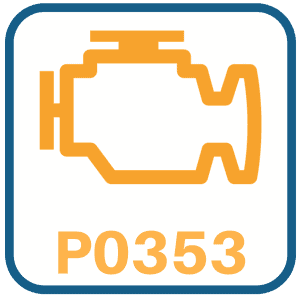P0353 indicates that ignition coil “C” is malfunctioning on its primary or secondary side. It is typically caused by a bad coil pack or wiring harness issue, and is a generic code. This means that it has the same meaning regardless of what vehicle throws the code. It is typically caused by a bad coil pack, spark plug, or wiring problem.
The first thing that you need to do when diagnosing it is to figure out if the issue is coming from the primary or secondary wiring system.
The primary wiring is the wiring harness leading from the PCM to the ignition system itself. A short, open, or poorly ground wiring harness is almost always what causes P0353 when it is the primary wiring side that has thrown the code. Look for visible damage.
The secondary side of the equation is the spark side. Which means that plugs, plug wires (if so equipped) or the spark plug itself are causing the code. Ignition Coil “C” indicates the problem is in cylinder three. You’ll need to look up which cylinder is number three on your engine. Different manufacturers use different methods. Here’s a pretty good explanation of how how to locate the third cylinder .
P0353 Symptoms
- Service Engine Light– The check engine light may be all that you notice when you have this code, particularly if it is caused by an intermittent wiring issue.
- Misfiring– P0353 might be accompanied by P0303. P0303 indicates that there is a misfire in cylinder 3. Resolving P0353 will typically clear P0303. A misfire can lead to a lack of power, and/or engine hesitation.
- Rough Idle– You vehicle may idle rough if the third cylinder isn’t getting enough spark. You may smell raw fuel as the engine runs as well, since the third cylinder is no longer igniting fuel efficiently.
P0353 Causes
These are the most common reasons that P0353 may have appeared in your car or truck.
- Wiring Issues (short, open, or bad ground)
- Bad Coil Pack
- Loose Connection at the coil
- Bad PCM
P0353 Diagnosis
Diagnosing P0353 is pretty straightforward. Finding out if the primary or secondary wiring harness is the problem is the first thing that you should do. It’s easy to do, even with no specialty tools.
Voltage Test (Optional, but time saving)
The first place that you would want to start looking for what could be causing P0353 in your vehicle would be the wiring harness. You can use a digital voltmeter to check if the coil pack “C” is getting the proper signal. You would want to set it for A/C hertz and check to see if it is between 5-20hz.
If it was between 5-20hz, it’s highly likely that the coil pack has gone bad. Although, it could also be a bad plug or plug wire as well. If you don’t have a voltmeter, no problem. Just check out the parts swap method below ↓.
Parts Swap
A great way to determine if it is an ignition related component, and not a wiring issue, is to reset the trouble code and swap the coil, plug, and plug wire (if equipped) with another cylinder. If the misfire returns in the cylinder that you’ve just swapped your ignition components into, then you know that you are looking at is a coil, plug wire, or (most likely) coil pack failure.
If the misfire did move cylinders, you can go ahead and replace the plug, plug wire, and coil pack. If you are on a tight budget, you can keep resetting the code and swap the ignition parts back one at a time until the misfire returns to cylinder three. Start with the coil pack unless you noticed that the plug looked foul.
Wiring
If the misfire failed to move from cylinder three, then you know that you most likely have an issue with the wiring harness going from the coil pack to the PCM. Take a look at where the harness plugs into the coil pack. Is it damaged or loose feeling in relation to the other cylinder’s connections? If so it may need to be replaced.
If the misfire is intermittent, go ahead and jiggle the wiring harness and see if it has an impact on the way the engine is running. If it does start or stop misfiring, you know you’ve found your problem. Look anywhere that the harness bends or touches anything sharp. Check for damage and repair the wiring accordingly.
Make sure that it has a solid ground.
PCM/ECM
If you still can’t find the problem, it’s time to take a look at the PCM. This is the least likely answer.
Conclusion: P0353
P0353 is usually pretty easy to diagnose through the swap test, even if you don’t have any specialty diagnostic tools. Good luck repairing your vehicle

